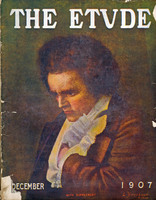FROM the vast number of girls and young women who study piano, it would be reasonable to suppose that there should bea much larger number of women who could succeed as virtuosi. Strange as it may appear, this is not the case. The reason for the failure of young women to succeed is not difficult to explain. Froma long experience in teaching, during which large numbers of young women have come under my observation, I have reached the following conclusions:—
First. As a rule, young women do not possess the physical strength necessary to carry them through the immense amount of hard work required to overcome the many technical difficulties with which the pianist’s path is beset. The student either underestimates these difficulties or is overcome by them during the progress of her studies.
Second. It is a peculiar fact that those who possess physical strength frequently lack sufficient talent, temperament, perseverance and concentration of purpose to enable them to attain great pianistic heights. Virtuosoship can never be achieved except by hard effort, accompanied by talent, persistence and an iron physique.
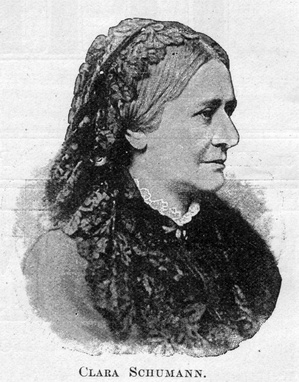 Clara Schumann.
Clara Schumann.Among the first very great women pianists to attract extensive attention was Clara Wieck, the wife of Robert Schumann, and better known as Clara Schumann. Although, even to-day musicians and critics still rank Clara Schumann as the greatest of women pianists, I personally doubt whether her technic was as great as that of several of the women pianists of our day. She was the pupil of her father, Friederick Wieck, who was also at one time the teacher of Schumann. Her musical instruction commenced when she was five years old, and when she was nine she made a public appearance and at the age of ten played at the Gewandhaus (the famous concert hall of Leipzig). When twelve she started to make tours of European cities and when sixteen received the unusual distinction of Imperial Chamber Virtuoso in Vienna. In 1840, at the age of twenty-one, she married Robert Schumann. Her father was so much opposed to the union—through a mistaken estimate of Schumann’s ability and chances for success—that Schumann was obliged to apply to the courts to secure permission to marry his old teacher’s daughter. As a girl and young woman, it is said that Clara Schumann devoted most of her attention to the brilliant music of Herz, Kalkbrenner and other writers of the period. After her marriage with Schumann, it is related that he taught her the classics, including his own and Mendelssohn’s compositions. Her mastery of the works of these two composers was everywhere acknowledged.
While living in Leipzig I was fortunate enough to hear Mme. Schumann at five concerts. Two concerts were given with the celebrated Gewandhaus orchestra and at these concerts she played the Schumann Concerto in A minor and the Mendelssohn Concerto in G minor. Her playing was perfect from the standpoint of high musicianship, but nevertheless it was not characterized by that brilliant technical dash with which I have heard these compositions played by other pianists since then. At her recitals she played, among other things, Sonata in D major, Op. 28 (Pastoral), Beethoven; Ballade in A flat, Chopin; Scherzo in B flat minor, Chopin; some valses and nocturnesby Chopin; two caprices and three songs without words, by Mendelssohn; two pieces by Schumann and Henselt’s “Poem d’Amour.” While the musicianship she exhibited in these pieces was impeccable there was nevertheless an absence of the astonishing technical skill and fluency some of our present day women pianists display. Her technic was always equal to the demands of the composition she endeavored to interpret, but measured by present standards she would very probably not be considered very unusual from the technical standpoint, and, in fact, many of our very ordinary women pianists might even excel her in this particular.
She had nine children and after the tragic death of her distinguished husband she was obliged to resume her concert work and teaching. From 1878 to 1892 she taught at the splendid Hoch Conservatory in Frankfurt am Main. In London she was immensely popular and had a large circle of loving friends in that city. Personally she is said to have been exceptionally charming and lovable. She continued her public work even to a very advanced age, when she became afflicted by deafness and was forced to retire.
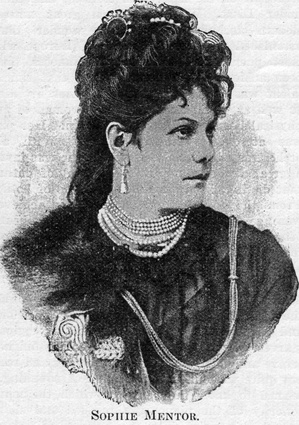 Sophie Mentor.
Sophie Mentor.Sophie Mentor was one of the most famous pupils of Franz Liszt. She was born in Munich in 1848. She studied there with Schoenschen, Lebert and Niest. Later she came under the instruction of the marvelous Taussig and thereafter under Liszt. With two such great masters of modern technic, it is little wonder that she astonished the musical public of Europe with the most phenomenal technical attainments that had been achieved by a woman up to that time. Her talent was most pronounced in other artistic lines as well as in music. She was a woman of greatest physical beauty and personal charm. Her presence was at once noble and kindly. With all the orchestras with which she played she was invariably a great favorite and raised a kind of enthusiasm that distinguished her among players of both sexes. From the technical standpoint her achievements were so great that many people who heard her often failed to note the underlying basis of profound and learned musicianship which this remarkable woman possessed. No pianist ever had that peculiar asset, “personal magnetism,” to a greater degree than did Sophie Mentor. She could play the most prodigious difficulties with precision, ease and effectiveness. Her scales and arpeggios were marvels of agility, grace and musicial (sic) finish. Her octave and chord passages were strong and resonant, but quite without any suggestion of pounding. She seemed to know the point at which the maximum sonority of the piano was reached and she never passed this point into the regions of cacophony. Her repertoire was almost without limit. It included all the greater works of Mozart, Bach, Weber, Beethoven, Mendelssohn, Chopin and Liszt —all of which she played from memory—rarely missing a note. For some unaccountable reason she refused several profitable offers to play in America and we thereby have lost an opportunity to hear one of the most brilliant, talented and most remarkable of all pianists. It was my good fortune to hear her several times and I was invariably fascinated beyond description. Her temperament was extremely musical and she no doubt inherited from her father, a renowned ‘cello virtuoso, much of that warmth of tone, color and wealth of technical finish. She married the celebrated composer for the ‘cello, Popper, but was divorced from him later. She became court pianist to the Prince of Hohenzollern and to the Emperor of Austria. Later she became professor of pianoforte at the St. Petersburg Royal Conservatory and among her pupils was Wassily Sapkellnikoff, the renowned Russian virtuoso.
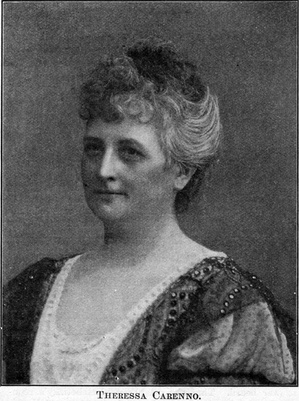 Theressa Carreno.
Theressa Carreno.Theressa Carreno has been regarded by many as an American pianist, although she has spent the greater part of her life in Europe. She was born in Caracas, Venezuela, in 1853, and her early education was received in New York. Among her teachers was the pianist composer, Louis M. Gottschalk. I first heard her in Boston, at one of the Thomas concerts, when she was about twenty years of age. She played the B minor Caprice of Mendelssohn and showed great promise and talent. Her playing even then was characterized by unusual technical ability and brilliance.
She was young and fine appearing and I remember that I was greatly impressed. Thereafter she went to Paris and became the pupil of George Mathias, a pupil of Savard, Halevy, Kalkbrenner and Chopin. It may thus be observed that the educational influences that formed her early work were somewhat different from the customary Liszt, Leschetizky, Scharwenka, or Kullak courses so many of her contemporaries adopted. She has been married several times and among her husbands have been no less than the pianist d’Albert and the violinist Sauret, both well known in America. Her playing, while not erratic, is marked by great individuality. Her technical attainments are on a par with the greatest pianists of all time and she is fired with a southern impassionate disposition and its antithetical complements “dreaminess and oriental mysticism,” so that her playing ranges from the most astonishing flights of brilliance to the most subtle delicacy. Her repertory is very extensive and she has no contemporary rival of her sex who excels her in the particular points of excellence to which we have referred. She has been criticised for playing too loud, upon more than one occasion, and some critics feel that her touch is at times unnecessarily harsh.
Anna Mehlig.
Anna Mehlig, another celebrated Liszt pupil visited America in the early seventies and resided here some three years. She played successfully with the Thomas and Boston Orchestras. She was tall and ungainly in appearance and her playing was decidedly masculine. At her concerts I never felt myself charmed or “carried away” by her playing, as it seemed to me to lack refinement, finish and sincerity. She was considered a leading exponent of the “Stuttgardt” school of pianoforte playing, which was marked by the conspicuousness of the technical means used to reach an artistic end. Her intellectual achievements were evident and she was courted and respected by musical people everywhere. She invariably played with her notes before her.
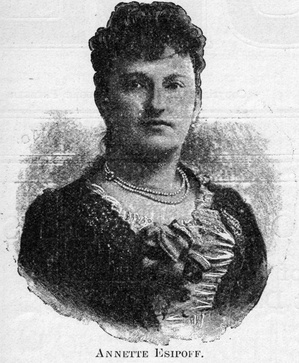 Esipoff.
Esipoff.Mme. Annette Esipoff (or Esipova), once the wife of the famous piano pedagogue Leschetizky, was one of the finest woman pianists I have ever heard. Her personality, like that of Carreno and Mentor, was extremely charming. She was born in St. Petersburg in 1851, and studied with Wielhorski and Leschetizky, marrying the latter in 1880. She toured America in 1876 and I had the pleasure of hearing her in the city of Boston, whither she had come unknown and unheralded. Leschetizky at that time was also unknown, but after Mme. Esipoff’s first concert in Boston both names at once became famous in American musical circles. She possessed talent, technic and tact, and ere long she had musical America at her feet. Her technical, artistic and musical finish was more satisfying than that of any other woman pianist I have ever heard. That she established Leschetizky’s reputation there can be no doubt, but unfortunately the married life of the couple was not successful and Esipoff, after separating from her teacher husband, whom she had done so much for, died in the city of St. Petersburg a few years ago, almost buried in the pathetic mantle of oblivion Time is wont to cast over interpretative artists. She was “Pianist to the Prussian Court” and also became a teacher in the St. Petersburg Royal Conservatory.
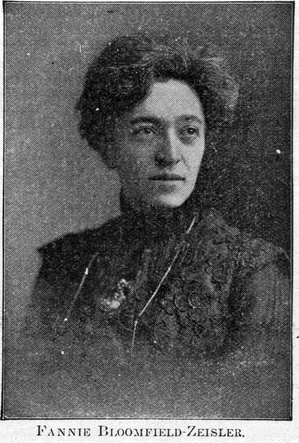 One of the most extraordinarily successful of all women pianists has been Mrs. Fannie Bloomfield-Zeisler, of Chicago. She was born in Bielitz (Austrian Silesia,) in 1866, but came to America with her parents in 1868 and since then her home has been in Chicago. Her education has been chiefly American. She studied with Carl Wolfsohn (recently deceased) and found in him a teacher willing to make any sacrifice, no matter how great, to his extremely high art ideals. Shortly after Mme. Esipoff’s remarkable American tour she went to study with Leschetizky in Vienna upon Esipoff’s recommendation, for even at the age of ten Mme. Zeisler showed most pronounced talent. She remained with Leschetizky for five years and soon thereafter she commenced her concert work. She has been equally successful in Europe and America and rarely appears in any part of the musical world without creating a furore. She appeared in most all of the great cities of continental Europe with invariable success. Although somewhat frail she plays the masterpieces demanding great physical strength in a manner which is always astonishing. All her work is marked by a pronouncedly individual temperament, great earnestness and periods of apparent deep absorption in her interpretative work which bring it to the borders of high musical inspiration. There is also a peculiar personal magnetism connected with the public work of Mme. Bloomfield-Zeisler, which may account for the unusual psychological sway she seems to hold over her auditors.
One of the most extraordinarily successful of all women pianists has been Mrs. Fannie Bloomfield-Zeisler, of Chicago. She was born in Bielitz (Austrian Silesia,) in 1866, but came to America with her parents in 1868 and since then her home has been in Chicago. Her education has been chiefly American. She studied with Carl Wolfsohn (recently deceased) and found in him a teacher willing to make any sacrifice, no matter how great, to his extremely high art ideals. Shortly after Mme. Esipoff’s remarkable American tour she went to study with Leschetizky in Vienna upon Esipoff’s recommendation, for even at the age of ten Mme. Zeisler showed most pronounced talent. She remained with Leschetizky for five years and soon thereafter she commenced her concert work. She has been equally successful in Europe and America and rarely appears in any part of the musical world without creating a furore. She appeared in most all of the great cities of continental Europe with invariable success. Although somewhat frail she plays the masterpieces demanding great physical strength in a manner which is always astonishing. All her work is marked by a pronouncedly individual temperament, great earnestness and periods of apparent deep absorption in her interpretative work which bring it to the borders of high musical inspiration. There is also a peculiar personal magnetism connected with the public work of Mme. Bloomfield-Zeisler, which may account for the unusual psychological sway she seems to hold over her auditors.Other famous women pianists have been Mme. Julie Rive-King, Madelane Schiller, Adele Aus der Ohe, C. Chaminade, Szumowska and Mrs. H. H. A. Beach. Many young American pianists of the day show great promise of being ranked with the celebrities in years to come.


